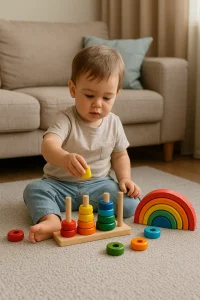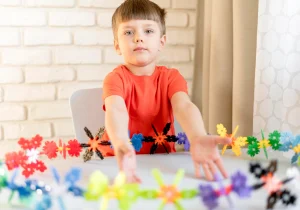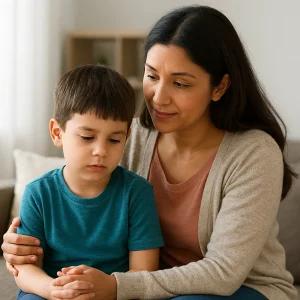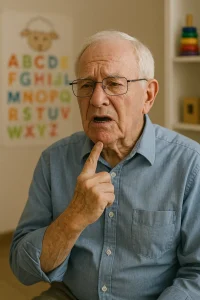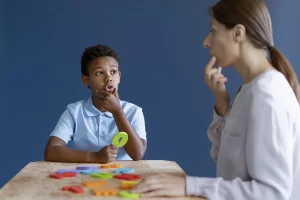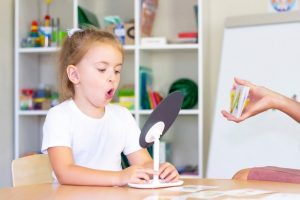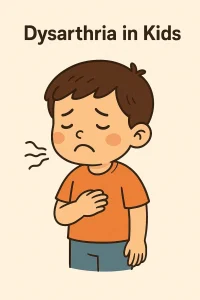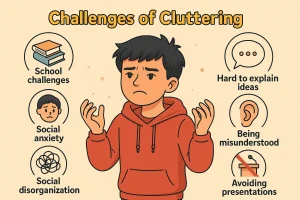12 Must-Know Insights on Childhood Apraxia of Speech
Last Updated: March 31, 2025
Imagine your child knowing exactly what they want to say but struggling to get the words out. For many families, this heartbreaking scenario is a daily reality—caused by a condition known as childhood apraxia of speech (CAS). CAS is a motor speech disorder where the brain has difficulty coordinating the mouth muscles needed to speak, even though the child has a clear idea of what they want to communicate. Unlike typical speech delays or issues caused by muscle weakness, apraxia affects the brain’s ability to plan and execute the precise movements for speech. Early recognition and targeted speech therapy for apraxia can make a significant difference in a child’s communication and confidence.
If you suspect your child may have apraxia, don’t wait. Early intervention is key. Explore our online speech therapy for kids to get expert support tailored to your child’s unique needs. Help them find their voice—one word at a time.
The Challenges of Childhood Apraxia of Speech
Recognizing the Early Signs of Apraxia
Childhood Apraxia of Speech (CAS) can be a perplexing condition, often leaving parents puzzled about why their child struggles with speech milestones that seem to come naturally to others. Early detection is key to managing this condition effectively, so recognizing the signs is crucial.
Insight 1: Delayed Speech Milestones
One of the most noticeable signs of apraxia in young children is a delay in reaching speech milestones. Unlike their peers, children with apraxia might not babble as infants, and their first words could come much later than expected. This delay isn’t just about slow development; it’s about how the brain communicates with speech muscles, which is less about timing and more about connection.
Insight 2: Inconsistent Errors and Difficulty with Complex Sounds
Children with apraxia often make inconsistent errors when trying to form words. One day, they might say a word relatively clearly, and the next, they might struggle to articulate the same word. Complex sounds and sequences are particularly challenging. This inconsistency can be confusing for parents who may see their child’s fluctuating abilities as a lack of effort or attention, but in reality, it’s a hallmark of apraxia.
How Apraxia Impacts Daily Communication
Insight 3: Struggles with Forming Words Correctly
The core of apraxia lies in the difficulty of forming words correctly on a consistent basis. This goes beyond simple mispronunciation. Children with apraxia know what they want to say; however, their brains have trouble planning and executing the necessary lip, jaw, and tongue movements. This can lead to highly unintelligible speech, making it hard for others to understand them, which is incredibly frustrating for the child.
Insight 4: Frequent Frustration and Communication Breakdowns
Imagine knowing what you want to express but being unable to say it clearly. For children with apraxia, this is a daily reality, often leading to significant frustration. These emotional outbursts can affect their social interactions and academic performance. Communication breakdowns aren’t just about speech; they influence a child’s confidence and willingness to interact with the world around them.
Navigating Through Apraxia with Effective Strategies
Navigating childhood apraxia of speech requires a multifaceted approach, combining professional therapy techniques with supportive strategies at home and in educational settings. Here’s how families and educators can employ effective methods to significantly improve communication skills in children dealing with apraxia.
Speech Therapy Techniques for Apraxia
Speech therapy plays a crucial role in helping children with apraxia improve their ability to communicate. Here are some core techniques used by therapists:
Insight 5: Role of Repetition and Motor Planning
Speech therapy for apraxia often involves extensive repetition of sounds, words, and phrases. This repetitive practice helps strengthen the brain’s motor pathways, making the movement needed for speech more automatic. Repetition enhances muscle memory associated with speech, allowing children to produce sounds with greater ease over time.
Insight 6: Visual and Tactile Cues to Aid Speech
Incorporating visual and tactile cues can significantly benefit children with apraxia. Visual cues might include gestures or pictures that help illustrate speech sounds, whereas tactile cues could involve touching the throat or face to feel the movement of muscles during speech. These strategies help children connect physical sensations with the sounds they need to produce, fostering better articulation and clarity.
Home and Educational Support for Children with Apraxia
Support outside of therapy sessions is equally important. Here’s how parents and educators can create an environment that promotes speech development:
Insight 7: Creating a Supportive Speaking Environment
A supportive speaking environment is key to encouraging children with apraxia to use their speech skills. This involves creating a patient, understanding atmosphere where children feel safe to express themselves without fear of judgment. Parents and teachers should offer plenty of time for the child to respond, avoiding rushing or completing sentences for them.
Insight 8: Using Technology and Apps to Enhance Communication Skills
Technology can be a powerful ally in the treatment of apraxia. Various apps and digital tools are designed to make speech practice more engaging and interactive. These tools often use games and activities that appeal to children, making practice feel less like work and more like play. Additionally, they provide consistent and correct models of speech sounds, which are vital for children who struggle with articulation.
Cultural Considerations in Speech Development
Understanding and embracing cultural diversity is fundamental when addressing speech development in children, especially for those facing challenges like apraxia. Speech patterns, language exposure, and therapeutic interventions can vary significantly across different cultural backgrounds, making it essential to adapt speech therapy practices to meet these diverse needs effectively.
Insight 9: Adapting Speech Therapy to Fit Cultural and Linguistic Backgrounds
Speech therapy isn’t one-size-fits-all, especially in a world as culturally rich as ours. Therapists must consider a child’s cultural and linguistic background to tailor their approach effectively. This adaptation might involve incorporating multilingual elements into therapy sessions or using culturally relevant materials and examples. For instance, if a child is bilingual, the therapist might work on speech patterns in both languages, recognizing that each language has its unique set of sounds and rhythms. This sensitivity not only makes therapy more effective but also respects the child’s identity and heritage, making them feel valued and understood.
Insight 10: Recognizing the Diversity in Speech Patterns and Therapy Acceptance
Cultural diversity influences not just speech patterns but also how speech therapy is perceived and accepted by families. In some cultures, there may be stigmas attached to speech disorders and seeking therapy. Recognizing these differences is crucial for therapists, as it helps them engage families more effectively and ensures that children receive the support they need in a manner that respects familial values and beliefs. For example, involving family members in therapy sessions can help demystify the process and show its benefits, thereby improving acceptance and cooperation.
Wellness Hub’s Comprehensive Support for Children with Apraxia
At Wellness Hub, we understand that each child with apraxia has unique needs and challenges. Our approach to therapy is designed to meet these individual differences with comprehensive, personalized care plans and advanced tools that enhance the effectiveness of speech therapy.
H3: Tailored Speech Therapy Approaches
Insight 11: Personalized Therapy Plans That Respect Individual Differences and Needs
Our experienced speech therapists begin with a thorough assessment to understand each child’s specific communication challenges and strengths. Based on this assessment, we develop a personalized therapy plan tailored to each child’s needs. These plans consider not just the linguistic abilities of the child but also their personal interests and family dynamics, which play a crucial role in engaging the child effectively. By focusing on personalized care, we ensure that our therapy addresses the child’s specific areas of need while also building on their strengths, thereby maximizing their potential for improvement.
H3: Advanced Tools and Resources
Insight 12: Specialized Tools and Digital Resources Available at Wellness Hub That Aid in Therapy for Apraxia
Wellness Hub incorporates the latest technology and digital resources to enhance speech therapy outcomes. Our range of specialized tools includes interactive applications that make learning fun and engaging for children, as well as software that allows for detailed tracking of a child’s progress over time. These tools are designed to supplement traditional speech therapy techniques, providing children with additional ways to practice and improve their communication skills both during therapy sessions and at home.
Discover more about our innovative tools and how they can support your child’s speech therapy journey by visiting our Online Speech Therapy for Kids. Here, you can explore the various options available and understand how our digital solutions make a difference.
Conclusion
Navigating childhood apraxia can be tough, but with Wellness Hub, progress is within reach. Our tailored speech therapies and cutting-edge tools help each child shine by enhancing their communication skills. Recognize the signs early, and let’s tackle apraxia together. At Wellness Hub, we’re excited to support your child’s journey to clearer communication. Join us now, and let’s make every word count!
Frequently Asked Questions:
1. What is childhood apraxia of speech?
Childhood apraxia of speech is a motor speech disorder where children have difficulty making accurate movements when speaking due to signaling problems between the brain and mouth.
2. How do I know if my child has apraxia?
Look for signs like delayed speech, inconsistent speech errors, and difficulty with complex sounds. If you notice these, consider consulting a speech therapist.
3. Can children with apraxia learn to speak clearly?
Yes, with the right speech therapy techniques and consistent practice, children with apraxia can improve their speech clarity significantly.
4. What are the best therapies for childhood apraxia?
Effective therapies often include extensive speech practice, repetition, and the use of visual and tactile cues to aid speech production.
5. How can I help my child with apraxia at home?
Create a supportive speaking environment, use technology and apps designed for speech practice, and engage in regular, fun speech exercises with your child.
6. Are there specific apps that help children with apraxia?
Yes, there are many apps designed to assist with speech development, providing interactive and engaging ways for children to practice speech.
7. What role does repetition play in treating apraxia?
Repetition helps strengthen the brain pathways needed for speech, making it easier for children to form words and sentences over time.
8. How does apraxia affect a child’s social life?
Apraxia can make social interactions challenging due to difficulties in communication, but with effective therapy, children can improve their speech and confidence.
9. How long does it take to see improvement in a child with apraxia?
Improvement timelines can vary widely among children with apraxia. Some may show noticeable progress within a few months, while others might need longer therapy. Consistent practice and tailored speech therapy are key to faster improvement.
10. Is apraxia something my child can outgrow?
Apraxia is not typically something children outgrow on their own; it requires targeted speech therapy to manage. However, with the right interventions, many children significantly improve their speech capabilities and can effectively manage the symptoms of apraxia as they grow older.
About the Author:
Shilpa Deshpande
Shilpa Deshpande is a skilled speech-language pathologist with over 14 years of experience. Fluent in Kannada, Telugu, Hindi, and English, she specializes in parent counseling, speech sound disorders, fluency assessment, and speech-language evaluations. Shilpa excels at working with children with developmental disorders, offering creative and effective therapy programs. Currently, at Wellness Hub, she holds a BASLP degree and is registered with the RCI. Her patience, ambition, and dedication make her a trusted expert in her field.
Book your Free Consultation Today
Parent/Caregiver Info:
Client’s Details:
* Error Message

